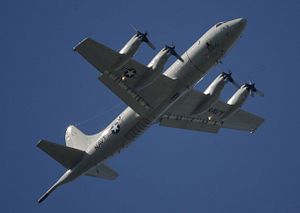On Thursday, the the U.S. and Indonesian navies carried out a joint maritime air patrol in the waters around the Natuna archipelago.
The patrol involved 88 personnel overall. The United States committed a P-3C Orion fleet comprising four ships and 21 personnel. In terms of Indonesian hardware, the Indonesian navy committed CN-235 and NC-212 short take-off and landing (STOL) maritime patrol aircraft in addition to a BO-105 helicopter.
The air patrol exercise focused on a variety of operational scenarios. In broad terms, it covered maritime domain awareness, intelligence, surveillance, and reconnaissance (ISR), and humanitarian assistance and disaster relief (HADR).
The Jakarta Port reported that the “Indonesian Navy’s Aviation Center and the US Navy held a joint sea surveillance exercise in the Malaka Strait and around Natuna Island, located in the South China Sea, to improve security as well as [sic] Pacific rebalance.”
The Jakarta Post cited the U.S. Embassy’s defense attaché, who remarked that the air patrol exercise was “part of the Pacific rebalance.”
Indonesia’s Navy Aviation Center commander, First Commodore Sigit Setiyanta, emphasized that the decision to hold the patrol was a routine joint exercise and entirely unrelated to broader South China Sea tensions.
“There’s no potential for conflict on Natuna. The drill aims to improve air patrol communication, search and rescue techniques and the exchange of information on the procedure of early detection and measures,” he noted in remarks given to the Jakarta Post.
The patrol takes place amid Indonesia placing more of an emphasis on stressing its sovereignty over the Natuna waters as China grows increasingly assertive in the South China Sea.
Several officials within the new Indonesian government have made remarks about Indonesia’s position on the Natuna issue, which is not formally regarded as a dispute of any sort with China.
Speaking in the United States in December 2014, a senior adviser to Indonesian President Joko “Jokowi” Widodo remarked that “the sovereignty of Indonesia cannot be negotiated…we are very, very firm on this.”
Formally, Indonesia is not a claimant to disputed waters in the South China Sea but there are concerns among officials there that China’s capacious dashed-line claim, which claims a huge swath of the South China Sea, could be interpreted to encompass waters considered part of Indonesia’s exclusive economic zone off the Natuna archipelago.
To this end, Indonesia pursues a cautious diplomatic approach to the Natuna issue, ever careful to avoid granting any legitimacy to the notion of a formal maritime territorial dispute with China. Last month, The Diplomat outlined the Indonesian government’s position on the South China Sea issue in detail.
The Natuna archipelago is composed of 157 islands spread across 262,000 square kilometers, of which 27 are inhabited.
































